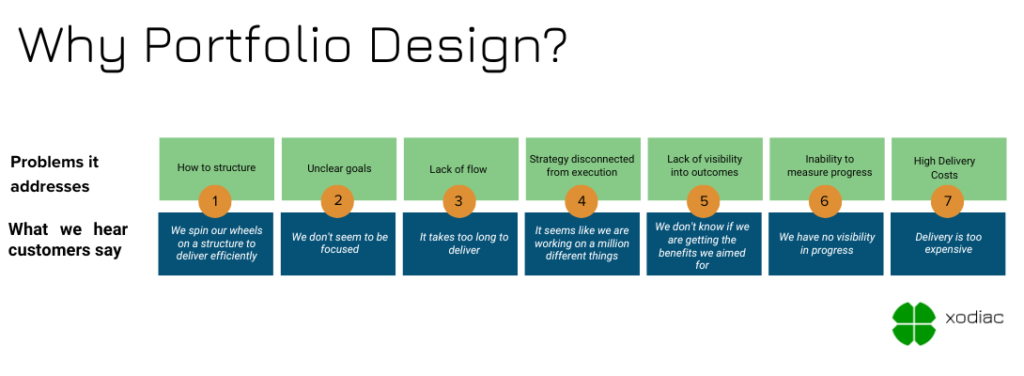The Path Forward: Solving strategic portfolio challenges with intentional design
In today’s fast-paced, ever-evolving business landscape, adaptability isn’t just a strength—it’s a necessity. Organizations that thrive are those that can sense change early, respond decisively, and continuously evolve. But while adaptability sounds great in theory, becoming a truly adaptable organization is anything but easy. The larger and more complex a company becomes, the harder it is to turn the ship quickly.
In our recent article, “7 Strategic Portfolio Management Challenges to Avoid,” we explored some of the most common—and costly—challenges that hinder organizations from realizing the flexibility they need to stay competitive. Links to those articles are below:
- Spinning Wheels: How Inefficient Structures Are Holding Back Your Success
- Lost Focus: The Silent Killer of Organizational Agility
- Delivery Delays: Why Your Projects Are Always Behind Schedule
- The Problem with Too Much Work in Progress
- Benefit Blindness: Are You Missing the Impact of Your Efforts?
- Invisible Progress: The Risks of No Visibility in Your Workflow
- When delivery expenses go through the roof
These issues are familiar to leaders and teams alike, manifesting in missed opportunities, wasted effort, and persistent frustration. The good news? There’s a solution.

Enter Portfolio Design: The answer to portfolio chaos
What do all these challenges have in common? They point to one root cause: an ineffective portfolio. Not just the list of projects your organization is undertaking—but the way that list was created, how it’s managed, the mechanisms that drive decision-making and prioritization, executing those initiatives, measuring them, and realizing their benefits.
Portfolio Design is the intentional structuring of work within an organization to enable responsiveness, strategic alignment, and effective delivery. It’s not about adding more process. It’s about designing a system that naturally creates flow, clarity, and impact.
When done right, Portfolio Design isn’t just a fix for one challenge. It becomes a framework that simultaneously addresses multiple issues—because many of the common pitfalls are interconnected. A clear, strategic portfolio design can improve delivery timelines, reduce cost, enhance visibility, and sharpen focus, all at once.
But Portfolio Design isn’t plug-and-play. Managing your portfolio strategically is a complex problem because organizations themselves are complex systems. People, structures, strategies, and culture all interact in ways that don’t always follow predictable patterns. The key is to approach strategic portfolio management with both systems thinking and organizational empathy, which is exactly what Portfolio Design does.
Over the next series of articles, we’ll take a closer look at six core elements of Portfolio Design, and how each one can help solve specific organizational challenges. But first, here’s a preview of what’s to come:
1. Align strategy to unleash your business vision
The foundation of any effective portfolio is alignment. Too often, teams work hard on the wrong things—projects that don’t directly contribute to the organization’s strategic goals. Without a clearly articulated and widely understood business vision, prioritization becomes a guessing game, and focus suffers.
A well-designed portfolio starts with clarity of purpose. What does success look like for the organization, and how does each initiative move the needle? When the business vision becomes the compass for every decision, teams gain direction, motivation, and a shared understanding of “why.”
Solves: Spinning Wheels: How Inefficient Structures Are Holding Back Your Success, The Problem with Too Much Work in Progress, Benefit Blindness: Are You Missing the Impact of Your Efforts?
2. Streamline your execution like a pro
Even with the right priorities, execution can falter. Bottlenecks, handoffs, unclear ownership, and misaligned processes slow progress and inflate costs. Prolonged delivery timelines aren’t just an execution issue—they’re a portfolio design problem.
Streamlining execution means designing the portfolio with delivery in mind. That includes selecting work that fits team capacity, organizing around value streams, and removing unnecessary dependencies. It’s about enabling flow, not just activity.
Solves: Delivery Delays: Why Your Projects Are Always Behind Schedule, When delivery expenses go through the roof, The Problem with Too Much Work in Progress
3. Refine structures to enable flow
An adaptable organization must move with purpose. Unfortunately, many are hampered by rigid hierarchies, fragmented governance, and siloed teams that obstruct flow. These structural issues often go unnoticed until they start impacting delivery.
Portfolio Design helps by establishing structures that encourage—not stifle—movement. This includes organizing work by customer value, creating cross-functional teams, and decentralizing decision-making where appropriate. It’s about aligning structure with the flow of work.
Solves: Spinning Wheels: How Inefficient Structures Are Holding Back Your Success, Invisible Progress: The Risks of No Visibility in Your Workflow, When delivery expenses go through the roof, Lost Focus: The Silent Killer of Organizational Agility
4. Master Events: Leverage key moments for portfolio success
Organizations are flooded with events—planning cycles, funding decisions, prioritization sessions, product launches, and retrospectives. When these aren’t synchronized, they create chaos. When they are, they become strategic levers.
Event mastery means designing your portfolio to integrate and orchestrate these events. It ensures that information flows smoothly across the organization and that every planning and delivery milestone is purposeful. Think of it as the rhythm of your organization.
Solves: Spinning Wheels: How Inefficient Structures Are Holding Back Your Success, Lost Focus: The Silent Killer of Organizational Agility, Delivery Delays: Why Your Projects Are Always Behind Schedule
5. Make better decisions using the right metrics
You can’t improve what you don’t measure—but you also can’t act on noise. Many organizations are buried in data but starved for insight. Measurement should illuminate progress, guide decisions, and reinforce strategy—not just tick boxes.
Portfolio Design includes identifying an organization’s critical metrics. These tell you whether you’re building the right things, building them efficiently, and actually delivering value. It’s not about dashboards—it’s about making decisions.
Solves: Invisible Progress: The Risks of No Visibility in Your Workflow, Benefit Blindness: Are You Missing the Impact of Your Efforts?
6. Use the right tools to manage your portfolio
Tools don’t solve problems—people do. But the right tools, thoughtfully integrated, can empower teams and clarify complexity. The wrong tools—or too many tools—create confusion, duplication, expense, and fragmentation.
Portfolio Design considers tooling from the start. This means choosing platforms that support collaboration, transparency, and adaptability—without becoming a burden. Tools should fit the workflow, not the other way around.
Solves: When delivery expenses go through the roof, Invisible Progress: The Risks of No Visibility in Your Workflow, Spinning Wheels: How Inefficient Structures Are Holding Back Your Success
Complexity requires thoughtful design
There’s no silver bullet for strategic portfolio management challenges, but there is a path forward. Managing a portfolio effectively is less about applying a methodology and more about solving a puzzle. Every organization is different, and the right design considers not just strategy, but culture, capability, and context.
Importantly, these six elements don’t exist in isolation. They interact. Improvements in one area often trigger improvements in another, and sometimes progress in a single domain is only possible after addressing a different one. This interconnectedness is what makes Portfolio Design both challenging and powerful.
So, what’s next?
Over the coming weeks, we’ll dive into each of these six elements of Portfolio Design. We’ll show how each contributes to a healthier, more adaptable organization—and how you can start applying them in your own context. From aligning on vision to mastering the rhythms of delivery, we’ll walk through practical insights to help you transform your portfolio into a true strategic asset.
Because in the end, adaptability isn’t just about reacting faster. It’s about designing your organization to move with clarity, confidence, and purpose.




